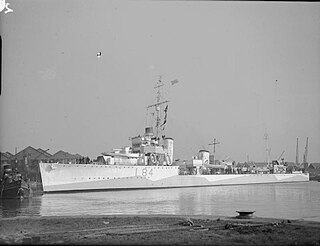Eight ships of the Royal Navy have been named HMS Ardent, whilst another two were planned:
Six ships of the Royal Navy have been named HMS Rodney, of which at least the last five were named after the Georgian Admiral George, Lord Rodney. A seventh was planned but never completed:

HMS Glowworm was a G-class destroyer built for the Royal Navy in the mid-1930s. During the Spanish Civil War the ship spent part of 1936 and 1937 in Spanish waters, enforcing the arms blockade imposed by Britain and France on both sides of the conflict. Glowworm was transferred from the Mediterranean Fleet shortly after the beginning of World War II to the British Isles, to escort shipping in local waters. In March 1940, she was transferred to the Home Fleet, just in time to participate in the opening stages of the Norwegian Campaign. On 8 April 1940 Glowworm encountered German destroyers transporting troops to invade Norway in Operation Weserübung. The German destroyers attempted to disengage while calling for help from the heavy cruiser Admiral Hipper. In the chaos of battle, the heavily damaged Glowworm rammed Admiral Hipper. The collision broke off the destroyer's bow, and she sank shortly afterwards. The commander of Glowworm was awarded the VC at the recommendation of the commander of Hipper. There were only two other occasions when a VC was awarded at the recommendation of the enemy in the Second World War.
Nine ships of the Royal Navy have been named HMS Grafton, while another one was planned:

The V and W class was an amalgam of six similar classes of destroyer built for the Royal Navy under the 9th, 10th, 13th and 14th of fourteen War Emergency Programmes during the First World War and generally treated as one class. For their time they were among the most powerful and advanced ships of their type in the world, and set the trend for future British designs.
Eight ships or submarines of the Royal Navy have been named HMS Anson, after Admiral George Anson:
Several ships of the Royal Navy have been named HMS Howe, after Admiral Richard Howe:

Lieutenant-Commander Gerard Broadmead Roope was a posthumous British recipient of the Victoria Cross, the highest and most prestigious award for gallantry in the face of the enemy awarded to British and Commonwealth forces.
Four Royal Navy ships have been named HMS Grenville. Vice Admiral Sir Richard Grenville was an Elizabethan sailor, explorer, and soldier:
Thirteen ships of the Royal Navy have been named HMS Shark after the shark:

Admiral Hipper was the lead ship of the Admiral Hipper class of heavy cruisers which served with Nazi Germany's Kriegsmarine during World War II. The ship was laid down at the Blohm & Voss shipyard in Hamburg in July 1935 and launched February 1937; Admiral Hipper entered service shortly before the outbreak of war, in April 1939. The ship was named after Admiral Franz von Hipper, commander of the German battlecruiser squadron during the Battle of Jutland in 1916 and later commander-in-chief of the German High Seas Fleet. She was armed with a main battery of eight 20.3 cm (8 in) guns and, although nominally under the 10,000-long-ton (10,160 t) limit set by the Anglo-German Naval Agreement, actually displaced over 16,000 long tons (16,260 t).
Operation Wilfred was a British naval operation during the Second World War that involved the mining of the channel between Norway and its offshore islands to prevent the transport of Swedish iron ore through neutral Norwegian waters to be used to sustain the German war effort. The Allies assumed that Wilfred would provoke a German response in Norway and prepared a separate operation known as Plan R 4 to occupy Narvik and other important locations.
Nine ships of the Royal Navy have borne the name HMS Diana after the figure from Roman mythology, whilst another was planned but later cancelled:

The Thornycroft type leader or Shakespeare class were a class of five destroyer leaders designed by John I. Thornycroft & Company and built by them at Woolston, Southampton for the Royal Navy towards the end of World War I. They were named after historical naval leaders. Only Shakespeare and Spenser were completed in time for wartime service. The other three were completed after the war, Broke and Keppel after being towed to Royal dockyards for completion, and two further ships - Saunders and Spragge - were cancelled. The function of a leader was to carry the flag staff of a destroyer flotilla, therefore they were enlarged to carry additional crew, offices and signalling equipment, allowing a fifth gun to be carried. These ships were very similar to the Admiralty type leader, but had Thornycroft design characteristics, the most noticeable being the broad, slab-sided funnels.
Three ships of the Royal Navy have borne the name HMS Pellew, after Admiral Sir Edward Pellew, 1st Viscount Exmouth, or his brother, Admiral Sir Israel Pellew. A fourth was planned but renamed before being launched:
The G-class destroyers were a proposed class of eight destroyers of the Royal Navy ordered during the Second World War under the 1944 Programme. Two were ordered on 24 July 1944, and six more on 30 August 1944, but all were cancelled on 13 December 1945, after the end of the war.
Five ships of the Royal Navy have carried the name HMS Handy:

The action off Lofoten was a naval battle fought between the German Kriegsmarine and the British Royal Navy off the southern coast of the Lofoten Islands, Norway during World War II. A German squadron under Vizeadmiral Günther Lütjens consisting of the battleships Scharnhorst and Gneisenau met and engaged a British squadron under Admiral Sir William Whitworth consisting of the battlecruiser HMS Renown and nine destroyers. After a short engagement, Gneisenau suffered moderate damage and the Germans withdrew.
Two ships of the Royal Navy have been named HMS Pasley, after Admiral Sir Thomas Pasley. A third was planned, but renamed before entering service.






